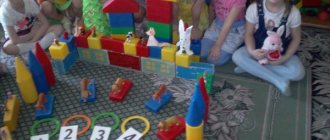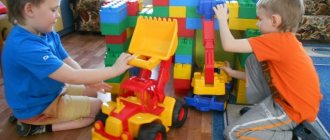Questioning.
- To identify the child's gaming interests and preferences at home, questionnaires or interviews with parents are used. II. Questions for parents: 1. Does your child often play at home? What games do you play most often? 2. Do you offer your child to play a specific game, do you insist if he does not express a special desire? 3.How do you do this? How do you choose games for your child? 4. How often do you offer your child a game plot that is new to him or does he offer it himself? Where do you think a child’s play stories come from? 5. Do you know which toys are most interesting to your child? 6. How much time a day does your child play independently? 7. Do you allow your child to play some games that are interesting to him, but which you don’t like? The following questionnaire is aimed at studying how teachers take into account children’s gaming interests when organizing role-playing games. III.Questions for educators: 1. Do you diagnose the gaming interests and preferences of your students? How do you do it? 2. Do you use diagnostic results for role-playing games? 3. How do you plan children's play activities (taking into account children's interests, without interests) 4. Do you insist that children play the games offered by the program? Do you think these games are always interesting for children? 5. How often do you offer children new game stories? Where do they come from? 6. Do you select game attributes for games, how do you do this? 7. Is there everything needed in the play area in your group for role-playing games? Does the content of this area correspond to the play interests of children? 8. Do you allow your children to play some games that are interesting to them if you don’t like them? Questionnaire for parents
Questions
Answer options Does your child often play at home? Yes No Your own option Do you know which toys are most interesting to your child? Yes No Your own option Do you allow your child to play some games that are interesting to him, but which you don’t like? Yes No Your own option How much time a day does your child play independently? Less than 1 hour 1 to 2 hours Your own option How often do you offer your child a game plot that is new to him or does he offer it himself? I offer it as needed Selects independently Your own option Where do you think a child’s play stories come from? From kindergarten games Television and computer games Your own option What games does your child play most often? desktop Role-playing Your own option Do you offer your child to play a specific game? Yes No Your own option Do you insist on choosing a game if he doesn’t express any particular desire? Yes No Your own option How do you choose games for your child? At your own discretion At the child's discretion Your own option Questioning of teachers
questions Answer options You diagnose the gaming interests and preferences of your students Yes No Your own option Do you use diagnostic results to organize a role-playing game? Yes No Your own option How do you plan children's play activities? Taking into account children's interests Clearly according to program recommendations Your own option Do you insist that children play the games offered by the program? Yes No Your own option Do you think these games are always interesting for children? Yes, sure No, but the program requires Your own option How often do you offer children new game stories? Until the child gets tired of the same plot of the game I try to offer a story once every 1 - 2 weeks Your own option Where do these stories come from? From the program from observations of children’s games and conversations with each other Your own option Do you select game attributes for games, how do you do this? Yes, we create attributes together with children No, we only use improvised means Your own option Is there everything you need in the play area in your group for role-playing games? Yes No (what exactly is missing) Your own option Does the content of this area correspond to the play interests of children? Yes No (what exactly does not match) Your own option Do you allow your children to play some games that are interesting to them if you don’t like them? Yes, sure Definitely no Yours in - Questions to talk with your child
1. Do you like to play? What are your favorite games, please name them?
2. Do you like the games you play with the kids in kindergarten? What about at home? What do you play at home?
3. Who are you most often in the game, what role do you play? Who else would you like to be?
4. Do you have any favorite toys? What toys do you like to play with, please show me? (the child is offered pictures or photographs of a variety of toys; you can walk around the group, examining all the toys in it).
5. Do you come up with games yourself or does someone help you? How do you do it, tell me?
When analyzing children's answers, it is necessary to pay attention to: - the playing interests and preferences of children in kindergarten and at home; - favorite stories and roles; - for your favorite toys;
It is necessary to observe children’s independent and teacher-organized games.
Observation Aspects:
— the child’s gaming interests (game plots and roles that are preferred);
— variety, stability, dynamism of game plots;
— dependence of the use of gaming skills on gaming interests;
- the nature of play interaction in conditions of an attractive, interesting role for the child.
The observation is carried out in natural conditions and allows us to see the influence of children’s gaming interests on the course of the game, its duration, the development of gaming skills, and the level of development of gaming activities. The results of the observation are documented in the protocol.
Protocol for monitoring independent and organized play activities of preschool children in the preparatory group .
| Child's name | Types of games and stories that children prefer | Game material | Diversity, stability, dynamism of game plots | Dependence of the use of gaming skills on gaming interests |
Find out the cost of writing such a paper!
Reply within 5 minutes! Without intermediaries!
42% of children have a low level of development of independent play, without adult guidance, 33% have an average level, and only 25% have a high level of development of play.
Thus, we see that this group of children is characterized by a low level of development of gaming skills. To improve the level of gaming skills of preschool children, we have developed a series of activities aimed at interaction between family and kindergarten.
2.2 Practical work on developing preschoolers’ gaming skills in the process of interaction between parents and preschool teachers
We can offer the following methodological recommendations for interaction between parents and preschool educational institutions: organization of such work according to the following plan:
- Consultation for parents “Age characteristics of children of the senior preschool group”, during which we will highlight the characteristics of the play activities of children of this age. (add.3)
- Questionnaire “How does your child play?” among parents. (add.4)
- Round table “Favorite toy”. (adj.5)
- Joint educational game “Field of Miracles of our Land.”
- Workshop “Game and its importance in a child’s life”, in which parents are actively involved. (adj.6)
- Theater performances. (adj. 7)
- Joint holiday themed events.
- Sports relay races “My family is the most athletic!” etc. (adj.8)
As well as organizing a collection of didactic games of various types. They are used in classes and in children’s independent activities. A didactic game can serve as an integral part of the lesson. It helps to assimilate, consolidate knowledge, and master the methods of cognitive activity.
The use of didactic games increases children's interest in classes, develops concentration, and ensures better assimilation of program material. Here, cognitive tasks are related to gaming ones, which means this type of activity can be called a game-activity.
In game-activities, the teacher thinks through the content of the game, methodological techniques for carrying it out, imparts knowledge accessible to children’s age, and develops the necessary skills. Assimilation of the material occurs unnoticed by children, without requiring much effort.
The educational effect of the game lies within itself. There is no need for special training in the game. The methods of play activity are conventional and symbolic, its result is imaginary and does not need to be evaluated.
Didactic materials can be divided into two groups. The first includes materials that provide children with opportunities to demonstrate independence when using them. These are a variety of construction sets and construction materials; plot-shaped and plot-didactic toys; natural material; semi-finished products (scraps of fabric, leather, fur, plastic). These materials allow children to experiment freely and use them extensively in games. At the same time, the child is free to choose methods of transformation and receives satisfaction from any result.
The second group included didactic materials specially created for the development of certain abilities and skills. They contain in advance the result that the child should receive when mastering a certain method of action. These are multi-colored rings of different sizes, insert toys, cubes, mosaics. Freedom of activity with these didactic materials is limited by the specific methods of action inherent in them, which the child must master with the help of an adult.
In the process of playing with didactic material, the tasks of familiarizing children with shape, color, and size are solved. The intellectual development of children is carried out - the ability to find common and different things in a subject, group and systematize them according to selected properties. Children learn to reconstruct the whole based on its part, as well as the missing part, disturbed order, etc.
The general principle of activity inherent in didactic games opens up wide opportunities for solving didactic problems of different levels of complexity: from the simplest (assemble a pyramid with three single-color rings, put together a picture of two parts) to the most complex (assemble a Kremlin tower, a flowering tree from mosaic elements ).
In an educational game, the child acts in a certain way; there is always an element of hidden coercion. Therefore, it is important that the conditions created for play provide the child with the opportunity to choose. Then didactic games will contribute to the cognitive development of each child.
So children must play. The game captivates children, makes their life more diverse and richer. All aspects of a child’s personality are formed in the game. Especially in those games that are created by the children themselves - creative or role-playing. Children reproduce in roles everything that they see around them in the lives and activities of adults. The role of play, unfortunately, is underestimated by some parents. They think that playing games takes a lot of time. It is better to let the child sit in front of the TV or computer screen, listening to recorded fairy tales. Moreover, in the game he can break something, tear it, get it dirty, then clean up after him. Playing is a waste of time.
And for a child, play is a way of self-realization. In the game he can become what he dreams of being in real life: a doctor, driver, pilot, etc. In the game, he acquires new knowledge and refines his existing knowledge, activates his vocabulary, develops curiosity, inquisitiveness, as well as moral qualities: will, courage, endurance, and the ability to yield. The game develops an attitude towards people and life. The positive attitude of games helps to maintain a cheerful mood.





